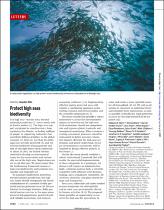| dc.contributor.author | Sills, Jennifer | |
| dc.contributor.author | Helm, Rebecca | |
| dc.contributor.author | Harden-Davies, Harriet | |
| dc.date.accessioned | 2022-06-20T13:14:20Z | |
| dc.date.available | 2022-06-20T13:14:20Z | |
| dc.date.issued | 2021 | |
| dc.identifier.citation | Sills, J., Helm, R. R. et al.(2021). Protect high seas biodiversity. Science, 372(6546), 1048-1049. doi:10.1126/science.abj0581 | en_US |
| dc.identifier.issn | 00368075 | |
| dc.identifier.uri | 10.1126/science.abj0581 | |
| dc.identifier.uri | http://hdl.handle.net/10566/7523 | |
| dc.description.abstract | The high seas—marine areas beyond
national jurisdiction (1)—cover nearly half
of Earth’s surface (2). The high seas support
our planet in countless ways, from
regulating the climate, to feeding millions
of people, to supporting industries that
contribute billions of dollars to the global
economy (3). Even so, less than 1% of the
high seas are fully protected (4), and the
current patchwork of management and
lack of oversight leaves them vulnerable
to abuse. In 2017, the United Nations
resolved to develop an international
treaty for the conservation and sustainable
use of the high seas. Negotiations are
set to end this year. We must ensure that
the forthcoming framework conserves
high-seas biodiversity and promotes sustainable
and equitable use. | en_US |
| dc.language.iso | en | en_US |
| dc.publisher | American Association for the Advancement of Science | en_US |
| dc.subject | High seas | en_US |
| dc.subject | Earth’s surface | en_US |
| dc.subject | Climate | en_US |
| dc.subject | Global economy | en_US |
| dc.subject | High-seas biodiversity | en_US |
| dc.title | Protect high seas biodiversity | en_US |
| dc.type | Article | en_US |

